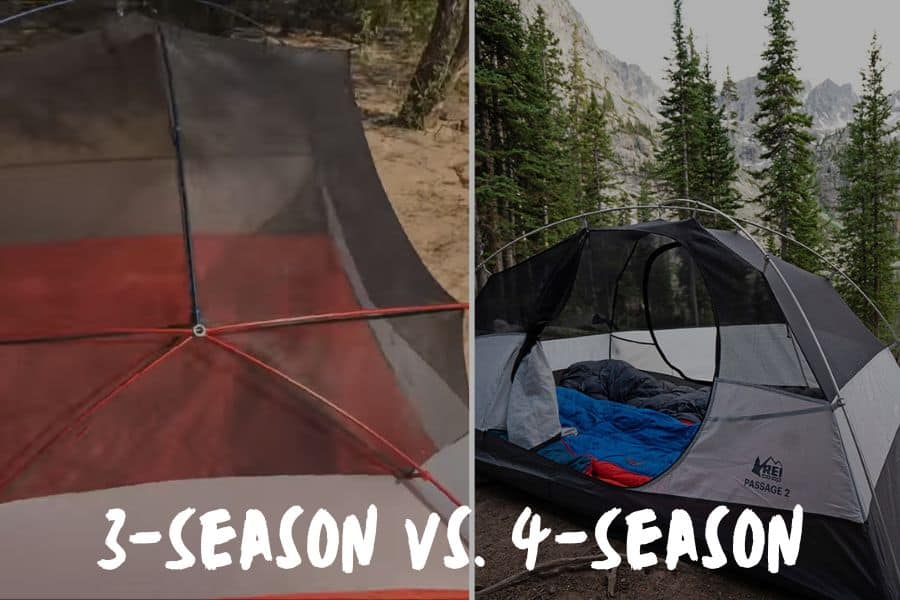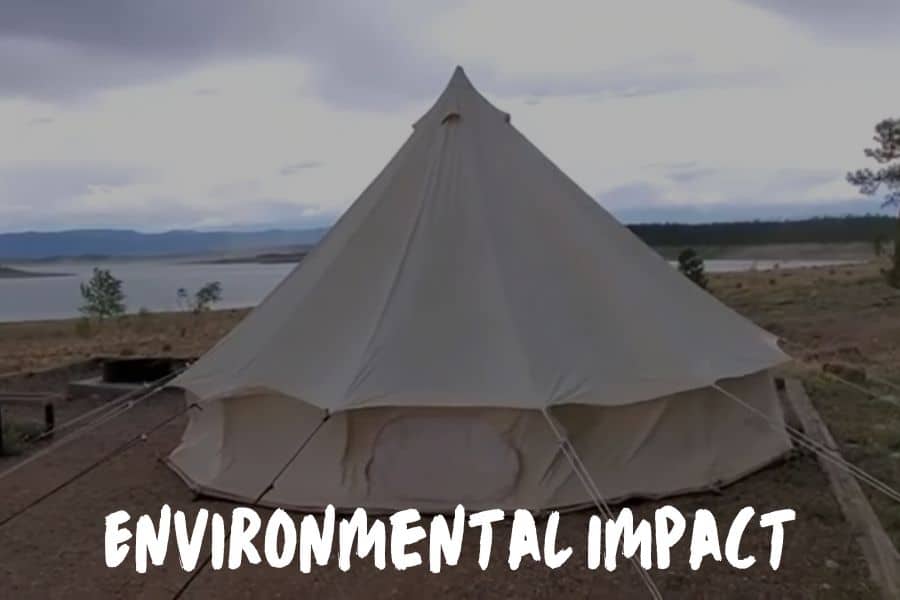What is the best tent material to buy?
The answer is simple…It all comes down to the kind of camping trips you’ll be going on.
Planning a backpacking trip? Weight will be at the top of your list of priorities.
Car camping? You might be more concerned about breathability and UV resistance.
Going camping in rough terrain? You’ll want to make sure your tent is made of a highly durable material.
Common camping tent materials you’re likely to come across in your search include:
- Nylon
- Polyester
- Canvas
- Polycotton
- Cuben Fiber
But if you’re simply looking for the best material, Dyneema Composite Fabric (DCF) – formerly known as Cuben Fiber is by far and away the best tent fabric that money can buy.
Once you know the pros and cons of each fabric, you should have a better idea of which one is best for you, based on your priorities.
Table of Contents
ToggleWhat Is The Best Tent Material?
There is no one best tent material for camping out on the market. Every material has its pros and cons which determine when it’s best used.
Overall, we agree that Dyneema Composite Fabric (DCF) – formerly known as Cuben Fiber – is great in several categories. It is waterproof, light in weight, and very strong.
And if you’re looking for a tent with these specific characteristics, then this material is the best.
However, keep in mind that where DCF shines in those categories, there are some ways that it lacks. For example, it is less durable and more expensive than other tent fabrics.
So, if these two categories are really important to you, you should consider one of the two synthetic materials, nylon or polyester.
Both of these materials come rather close to DCF in many categories, so they’re both a really good option for a tent.
Overall, there is certainly a tent fabric that is just right for you, and today, we’re going to help you by comparing all the pros and cons of each tent fabric.
Best Tent Material By Function
| Function | Material |
| Most Durable | Polycotton |
| Most Waterproof | DCF |
| Lightest | DCF |
| Most Eco-Friendly | Canvas (organic cotton) |
| Cheapest | Polyester |
| Most Expensive | DCF |
| Strongest | DCF |
Durability & Longevity

When it comes to durability, polycotton wins. It combines the best characteristics of both polyester and cotton.
Cotton fibers are already very strong, and they are further fortified with polyester fibers to prevent ripping or tearing.
Furthermore, polycotton has great UV resistance. This fabric will fade and degrade at a much slower pace than polyester or cotton would on their own.
Waterproofing

As for the waterproofness, it’s clear which material wins in this category: Dyneema Composite Fabric (DCF).
Unlike any other material we mentioned, DCF doesn’t absorb water – not even the tiniest bit.
Instead, the water drops simply glide off the fabric onto the ground. For that reason, it doesn’t need any additional coating, unlike other materials.
Also read: How To Waterproof A Canvas Tent
Cost & Affordability

Among all the tent fabrics, polyester is the most affordable option.
Polyester production is extremely inexpensive as it only involves petroleum, coal, water, and air.
Compared to nylon, another synthetic material, the polyester production cost is almost halved.
Also read: Top 9 Best Tents Under $100 (2023 Buyer’s Guide)
3-Season Vs. 4-Season

While 3-season tents work with a variety of materials, the best option for a 4-season tent is ripstop nylon.
Nylon traps heat better compared to other fabrics, which is a feature you absolutely want in a winter tent.
However, regular nylon would sag and stretch from snow and winds, which is why ripstop nylon works better here.
Lightweight Materials

When it comes to material weight, Dyneema Composite Fabric holds a well-deserved first place.
Until the invention of this fabric, nylon was the material reserved for backpacking tents.
However, since DCF weighs up to 30% less than nylon, it became the fabric of choice for ultralight tents.
Plus, since it doesn’t absorb water at all, unlike any other material, it doesn’t gain weight when sagged.
But don’t be fooled by the featherweight of DFC, as this material is incredibly strong for its weight.
With that being said, let’s not forget about the drawbacks that come with this fabric. These are vulnerable to tears and abrasions, are higher in cost, and are large when packed.
Environmental Impact

Finding the winner in this category is not as straightforward as it may seem.
Even though it’s made of natural fibers, cotton is not a very environmentally friendly fabric. First, it requires a lot of water to grow – 5,300 gallons for mere 2 lbs of cotton!
What’s more, most of the cotton grown globally is not organic, which means it involves genetically modified seeds and chemicals.
We must also take into consideration that cotton won’t last anywhere near as long as synthetic materials, like polyester or nylon.
So, it makes more waste in the same amount of time. Plus, making synthetic materials requires way less water.
However, synthetic materials:
- Are derived from fossil fuels.
- Require chemicals in production.
- Aren’t biodegradable.
So, what’s the material with the least environmental impact, then?
Well, that would be organic cotton. Producing organic cotton addresses most eco-challenges regular cotton production faces.
Not only does it avoid using chemicals, but it also involves ancestral farming methods that preserve soil.
Organic cotton tents aren’t as common as their non-organic counterparts. But, they’re definitely a good choice if you’re concerned about the environmental impact of your tent.
A Quick Comparison Of Tent Fabrics
| Material | Pros | Cons |
| Nylon | very lightweight, durable, quick-drying | limited water resistance, stretches over time, bad UV resistance |
| Ripstop Nylon | very breathable, quick-drying, lightweight, tear-resistant | heavier than nylon, limited water resistance |
| Polyester | affordable, durable, UV-resistant, stretch-resistant | heavy, prone to tearing |
| Ripstop Polyester | highly tear-resistant, durable, quick-drying | heavy |
| Canvas | very breathable, UV-resistant, well-insulated, water-resistant | very heavy, slow-drying, expensive, susceptible to mildew |
| Polycotton | breathable, highly durable, mildew-resistant | heavy, expensive |
| DCF | highly waterproof, stretch-resistant, patchable, extremely lightweight | Expensive, low durability |
FAQs
What Is The Best Waterproof Tent Material?
Unlike other materials, DCF is completely waterproof and lets water slide off the fabric, instead of absorbing it.
What Is The Strongest Tent Material?
DCF has the strongest fibers of all the tent materials. In fact, it is considered to be one of the strongest fibers in the world, at 15x the strength of steel per weight.
Do UV Rays Affect Tent Fabric?
Of course, sun rays degrade tent fabric like any other material.
However, not all fabrics degrade at the same pace. For instance, nylon has a much lower UV resistance than polyester.
What Is Ripstop Tent Fabric & Is It Good?
Ripstop fabric has a crosshatch weave pattern, which increases its resistance to tearing and ripping.
Basically, it has a stronger thread woven into a grid pattern to prevent holes from getting bigger.
What Is Dyneema Tent Fabric & Is It Good?
Unlike other materials, Dyneema is not woven. It is sandwiched between outer layers of polyester film that is then melded together in a high-pressure autoclave.
This material has great strength, waterproofness and low weight.
What Is The Lightest Weight Tent Fabric?
Dyneema is the lightest tent fabric on the market. Compared to nylon, another light material, Dyneema can weigh half of nylon’s weight.
What Is The Strongest Tent Fabric?
Among tent fabrics, DCF has the best strength-to-weight ratio.
Are There Any Unique Safety Considerations Associated With Specific Tent Materials?
Keep in mind that not all tent fabrics have the same properties. For instance, canvas may be more waterproof than some other synthetic materials, but it requires seasoning.
Likewise, Dyneema may be the strongest fabric, but it’s not as durable as other ones.
The Final Verdict
Which fabric is the best? Well, as you can see, there isn’t one right answer. It all depends on what your top priorities are.
If you’re a backpacker looking for a lightweight tent that won’t weigh you down, nylon is the way to go.
Extreme adventurers camping in rough terrain would probably be better off going for polyester.
Car campers can go for anything really, including canvas tents, which is an excellent choice if you don’t mind the extra weight.
And of course Dyneema Composite Fabric (DCF) is the best of them all!
Hopefully, you’ve now got a clearer picture of the best tent material for you. Happy camping!
More on Tents:


